Go further with GO Markets
Trade smarter with a trusted global broker. Low spreads, fast execution, powerful platforms, and award-winning customer support.
For beginners
Just getting
started?
Explore the basics and build your confidence.
For intermediate traders
Take your
strategy further
Access advanced tools for deeper insights than ever before.
Professionals
For professional
traders
Discover our dedicated offering for high-volume traders and sophisticated investors.
Get started with GO Markets
Whether you’re new to markets or trading full time, GO Markets has an account tailored to your needs.


Trusted by traders worldwide
Since 2006, GO Markets has helped hundreds of thousands of traders to pursue their trading goals with confidence and precision, supported by robust regulation, client-first service, and award-winning education.
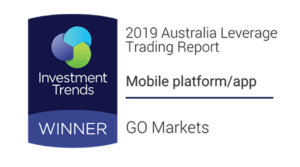
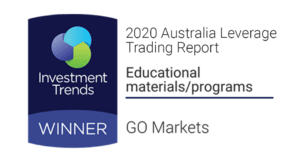
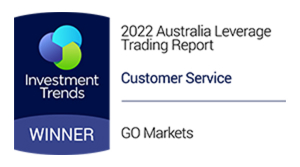
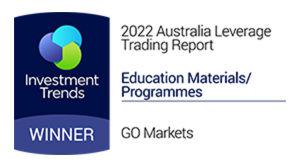

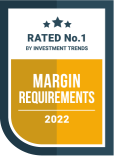


















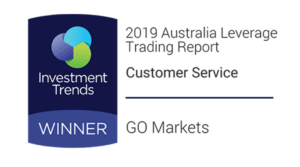
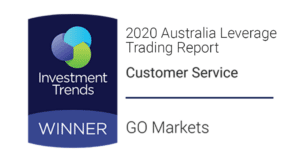
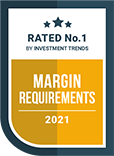
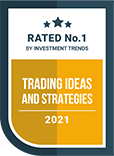
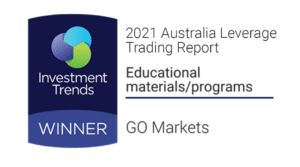
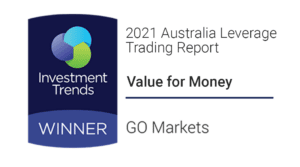







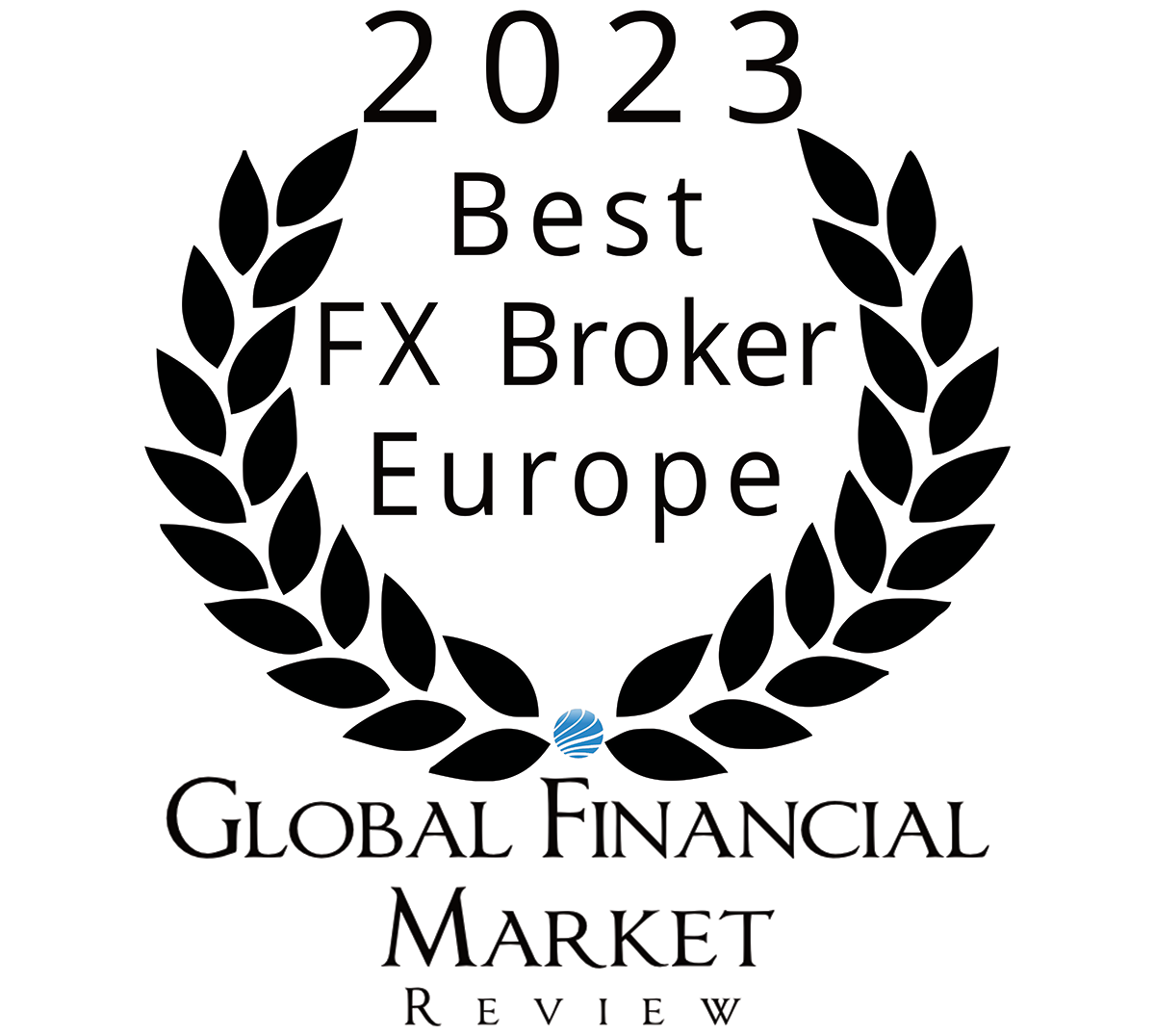






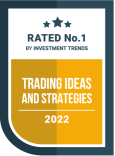

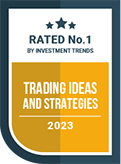

Explore more from GO Markets
Platforms & tools
Trading accounts with seamless technology, award-winning client support, and easy access to flexible funding options.
Accounts & pricing
Compare account types, view spreads, and choose the option that fits your goals.
Go further with
GO Markets.
Explore thousands of tradable opportunities with institutional-grade tools, seamless execution, and award winning support. Opening an account is quick and easy.


Go further with
GO Markets.
Explore thousands of tradable opportunities with institutional-grade tools, seamless execution, and award winning support. Opening an account is quick and easy.

Most traders understand EA portfolio balance through the lens of traditional risk management — controlling position sizes, diversifying currency pairs, or limiting exposure per trade.
But in automated trading, balance is about deliberately constructing a portfolio where different strategies complement each other, measuring their collective performance, and actively managing the mix based on those measurements.
The goal is to create a “book” of EAs that can help diversify performance over time, even when individual strategies hit rough patches.
A diversified mix of EAs across timeframes and assets can, in some cases, reduce reliance on any single strategy. This approach reduces dependency on any single EA’s performance, smooths your overall equity curve, and builds resilience across changing market conditions.
It’s about running the right mix, identifying gaps in your coverage, and viewing your automated trading operation as an integrated whole rather than a collection of independent systems.
Basic Evaluation Metrics – Your Start Point
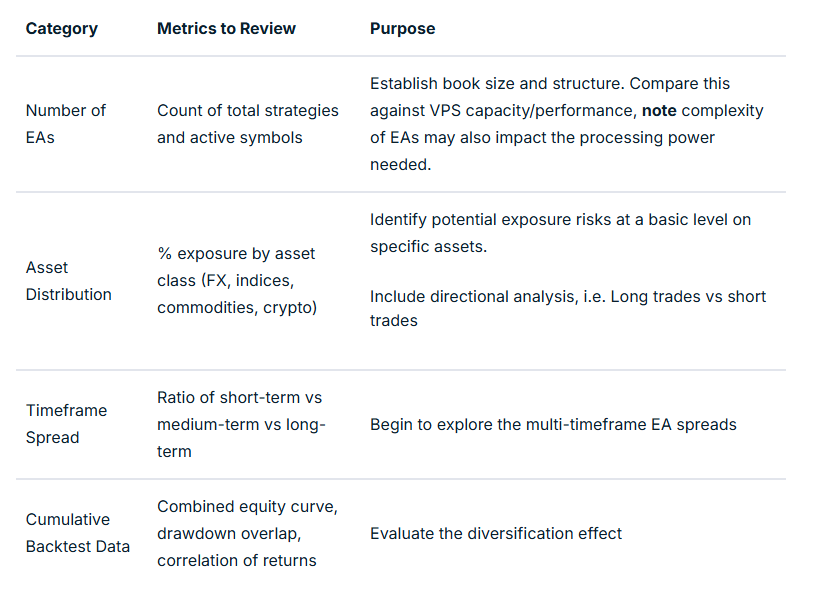
Temporal (timeframe) Balancing
When combined, a timeframe balance (even on the same model and instrument) can help flatten equity swings.
For example, a losing phase in a fast-acting M15 EA can often coincide with a profitable run in an H4 trend model.
Combining this with some market regime and sessional analysis can be beneficial.
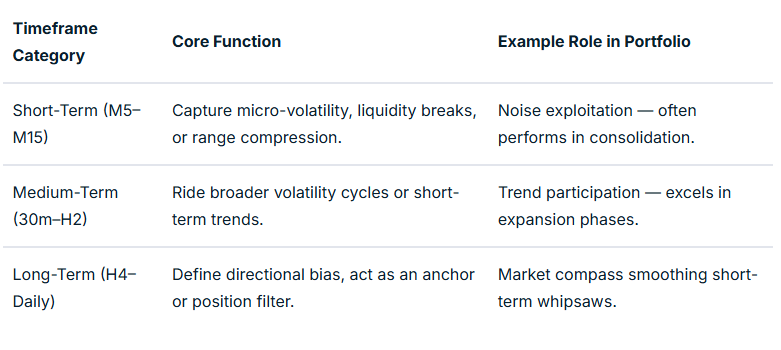
Asset Balance: Managing Systemic Correlation Risk
Running five different EAs on USDJPY might feel diversified if each uses different entry logic, even though they share the same systemic market driver.
But in an EA context, correlation measurement is not necessarily between prices, but between EA returns (equity changes) relating to specific strategies in specific market conditions.
Two EAs on the same symbol might use completely different logic and thus have near-zero correlation.
Conversely, two EAs on a different symbol may feel as though they should offer some balance, but if highly correlated in specific market conditions may not achieve your balancing aim.
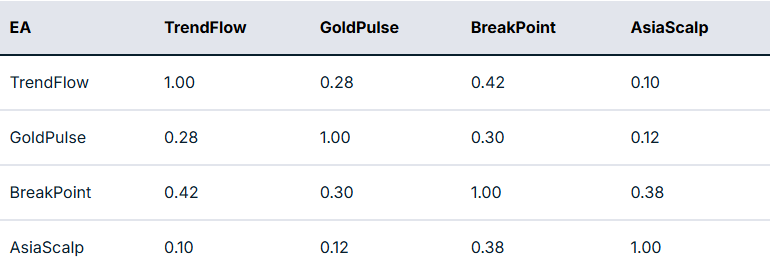
In practical terms, the next step is to take this measurement and map it to potential actionable interventions.
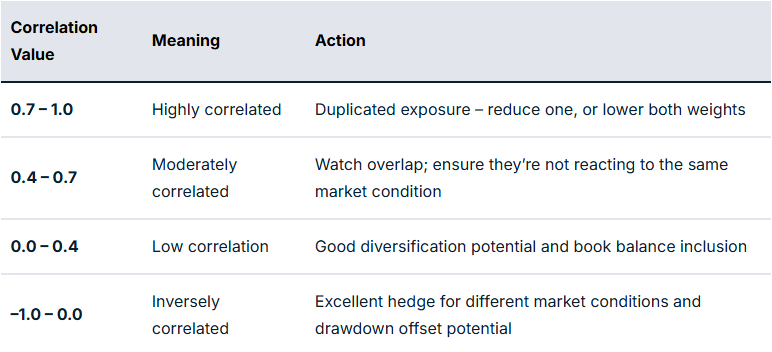
For example, if you have a EURUSD Trend EA and a GBPUSD Breakout EA with a correlation of 0.85, they are behaving like twins in performance related to specific market circumstances. And so you may want to limit exposure to some degree if you are finding that there are many relationships like this.
However, if your gold mean reversion EA correlates 0.25 compared to the rest of your book, this may offer some balance through reducing portfolio drawdown overlap.
Directional and Sentiment Balance
Markets are commonly described as risk-on or risk-off. This bias at any particular time is very likely to impact EA performance, dependent on how well balanced you are to deal with each scenario.
You may have heard the old market cliché of “up the staircase and down the elevator shaft” to describe how prices may move in alternative directions. It does appear that optimisation for each direction, rather than EAs that trade long and short, may offer better outcomes as two separate EAs rather than one catch-all.
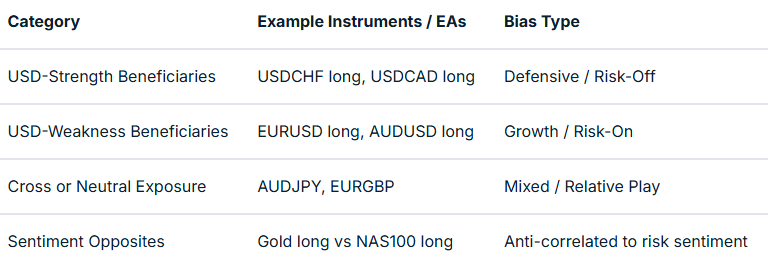
Market Regime and Volatility Balance
Trend and volatility states can have a profound impact on price action, whether as part of a discretionary or EA trading system. Much of this has a direct relationship to time of day, including the nature of individual sessions.
We have a market regime filter that incorporates trend and volatility factors in many EAs to account for this. This can be mapped and tested on a backtest and in a live environment to give evidence of strategy suitability for specific market conditions.
For example, mean reversion strategies may work well in the Asian session but less so in strongly trending markets and the higher volatility of the early part of the US session.
As part of balancing, you are asking questions as to whether you actually have EA strategies suited to different market regimes in place, or are you using these together to optimise book performance?
The table below summarises such an approach of regime vs market mapping:
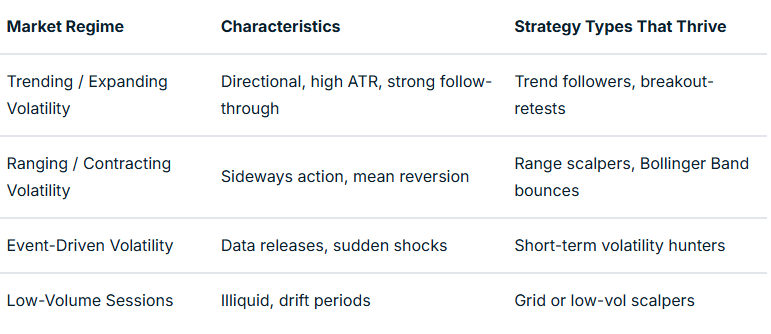
Multi-Level Analysis: From Composition to Interaction
Once your book is structured, the challenge is to turn it into something workable. An additional layer of refinement that turns theory and measurement into something meaningful in action is where any difference will be made.
This “closing the circle” is based on evidence and a true understanding of how your EAs are behaving together. It is the step that takes you to the point where automation can begin to move to the next level.
Mapping relationships with robust and detailed performance evaluation will take time to provide evidence that these are actually making a difference in meeting balancing aims.
To really excel, you should have systems in place that allow ongoing evaluation of the approaches you are using and advise of refinements that may improve things over time.
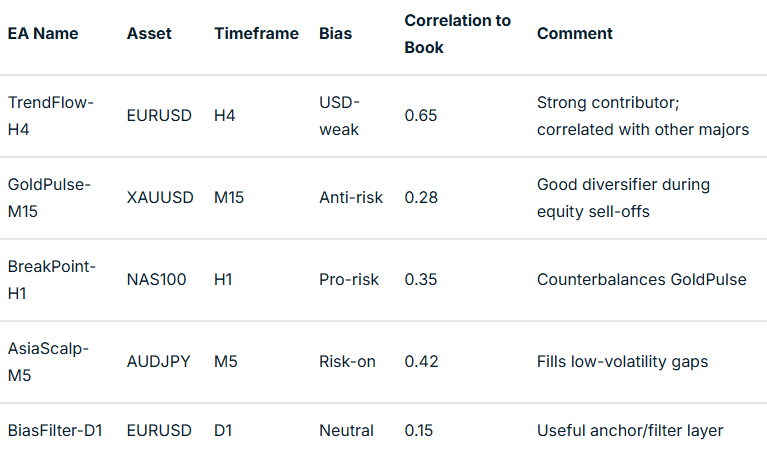
What Next? – Implementing Balance in Practice
Theory must ultimately translate into an executable EA book. A plan of action with landmarks to show progress and maintain motivation is crucial in this approach.
Defining classification tags, setting risk weights, and building monitoring dashboards are all worth consideration.
Advanced EA traders could also consider a supervisory ‘Sentinel’ EA, or ‘mothership’ approach, to enable or disable EAs dynamically based on underlying market metrics and external information integrated into EA coding decision-making.
Final Thoughts
A balanced EA portfolio is not generated by accident; it is well-thought-out, evidence-based and a continuously developing architecture. It is designed to offer improved risk management across your EA portfolio and improved trading outcomes.
Your process begins with mapping your existing strategies by number, asset, and timeframe, then expands into analysing correlations, directional bias, and volatility regimes.
When you reach the stage where one EA’s drawdown is another’s opportunity, you are no longer simply trading models but managing a system of EA systems. To finish, ask yourself the question, “Could this approach contribute to improved outcomes over time?”. If your answer is “yes,” then your mission is clear.
If you are interested in learning more about adding EAs to your trading toolbox, join the new GO EA Programme (coming soon) by contacting [email protected].

The rise of algorithmic trading has made it possible for traders of all levels to execute trades with precision and discipline 24/7.
However, while algorithms, such as Expert Advisors (EAs) used on MT4or MT5, remove emotion from the execution, they cannot remove the human element from trading.
The psychological challenges may be different when using EAs than those facing the discretionary trader, but challenges still exist.
Every automated strategy reflects the trading beliefs, thinking, logic, and discipline of its creator. This is true in development and in a live environment.
The “code” in EA trading should mean more than lines of MQL5. It should be based on a code of conduct that defines the standards by which you operate.
In a world where automation can amplify both success and mistakes, a structured set of principles helps ensure EAs remain a tool for improvement, not a shortcut to risk.
1. Use EAs as Trading Tools, Not Replacements for Good Practice
EAs are instruments, tools of the trade, not a replacement for skill, judgment, or responsibility. Their role is to supplement a trader’s edge, not substitute for it.
For example, a swing trader who relies on price-action patterns might automate only specific entry conditions to ensure consistency, while continuing to manage exits manually.
Conversely, a systematic trader may automate the entire process but still monitor performance against broader market regimes as a filter for entering or exiting automated trades.
Before an EA is ever switched on, traders must ask: What problem is this solving for me? Is it improving my execution discipline, making sure I miss fewer trading opportunities, or helping me diversify and trade efficiently across multiple markets?
Automation magnifies intent and thoroughness in peroration, execution and system refinement. If your answer is simply “to make money while I sleep,” the foundation is not enough, and perhaps you should look a little deeper.
2. Design with Clarity and Thoroughness
The design phase is where your EA professionalism begins. Every EA must be built on a clear, rules-based logic that matches the trader’s intent and desire to take advantage of specific price action.
In practice, this means you need to define exactly what the EA is supposed to do from the outset and, equally, what it will not do.
Integrity in design means documenting your logic before you code it. Write out the concept in plain language.
“Enter long when a bullish engulfing candle forms above the 20 EMA during the London session.”
“Exit when RSI crosses below 70 or after two ATRs in profit.”
Once defined, those conditions become the contract between the trader and the code.
Whether you are attempting to code yourself, using a third party to code for you or even using an off-the-shelf EA, ambiguity or lack of clarity should be addressed.
Without this, there will always be a temptation to shift or a failure to recognise the need for refinement.
3. Test with Transparency
Backtesting is often where enthusiasm overtakes discipline. It’s easy to be seduced by an impressive equity curve, yet testing is only valuable when it’s transparent.
Successful EA traders will often treat every backtest as additional data, not exclusive hard validation that an EA definitely perform in a live market environment.
They record settings, market conditions, and measure key metrics, saving results journal and different versions. This allows an objective comparison and sets the foundations for what should be measured on an ongoing basis.
Transparency also means using realistic conditions — spreads, slippage, and ticks rather than OHLC for final testing, all provide a greater quality of metrics that may more accurately mirror live trading.
A good practice is to maintain a “testing log” alongside the EA code. For example:
- Version number
- The purpose of the test (e.g., confirm logic or optimise ATR period for setting stop or take profit levels)
- The conditions under which it was run, including underlying market conditions and arguably directional and sessional differences.
- The interpretation of results (what was learned, not just the numbers)
4. Avoid the Illusion of Certainty
The temptation to fine-tune parameters until a backtest looks flawless is a trap known as overfitting.
It produces systems that may often perform brilliantly on historical data but collapse in a heap in live markets, where other external variables can be equally, if not more influential.
The necessity for and rigour and robustness in testing include approaches such as:
- Forward testing: Running the EA on new data to confirm behaviour.
- Walk-forward analysis: Re-optimising in rolling segments to ascertain whether there is parameter stability.
- Parameter clustering: Checking if profitability holds across a range of values rather than one precise setting. E.g., it will still be profitable if a level of partial close is 40, 50 or 60% of your position.
A robust EA trader accepts uncertainty as reality. A recognition that markets can evolve, conditions often shift, and no single setting is likely to remain optimal forever.
Your goal is durability, not perfection in a single set of market conditions.
An EA that performs moderately well across different conditions is often far more valuable than one that looks brilliant in backtest isolation.
5. Adequate Preparation for Live Execution
The transition from backtest to live trading is not something to take lightly; it is a major operational step. Before going live, traders should have a checklist covering readiness that includes confirmation of logic, appropriate infrastructure, and management of risk.
Steps to achieve this aim can include:
- Running the EA in visual backtest mode to confirm correct trade placement.
- Checking symbol specifications, such as contract size, margin requirement, and swap cost.
- Confirming VPS stability — low latency, sufficient processing power for the number of EAs you are trading, and reliability
- Testing on a demo account first, under live market conditions and then move to a live environment using minimum trading volume before scaling.
EA traders should have a set of minimum values for key metrics such as Net profit vs balance drawdown, win rate, consecutive wins and losses and Sharpe ratios before moving to live.
A full checklist that incorporates minimum testing performance as well as infrastructure management is critical.
6. Manage Risk is About You, Not Your EA
The most dangerous misconception in automated trading is that the EA “handles risk.” It does not. It simply executes your instructions, whether these are good or bad for a particular trade.
As a trader, you remain responsible for every lot size, margin call, and equity swing. Proper capital management means understanding total exposure across all running EAs as a whole, not just an individual one.
Running five EAs, of which risks 1% of account equity per trade is not necessarily diversification, particularly if the assets are heavily correlated.
In the same way that you should be rigorous in decision-making from test to live environment, it is equally important when scaling, i.e., increasing trading lot sizes.
Scaling rules should be data-based and only considered after a defined critical mass of trading activity of a single EA. Only increasing trade size when the EA’s equity curve maintains a positive slope over a rolling period, or when the profit factor exceeds a set threshold for a given number of trades.
Once scaling is taking place beyond the minimum volume, it may be worth considering the implications of the reality that risk is dynamic.
Experimenting with adjusting lot size against the strength of the signal or underlying market conditions for specific EAs may be worthwhile.
7. Monitor, Measure, and Refine
A live EA is not a “set-and-forget” machine. It’s a continuous process that requires observation and refinement on an ongoing basis
Regular and planned reviews of EA performance through appropriate reporting will always reveal valuable insights beyond your overall account balance. Aim to answer questions such as:
- Is the EA behaving as designed?
- Are trade times and volumes consistent with expectations?
- Has the average profit per trade decreased, suggesting a changing market structure?
A disciplined EA trader will use these insights to decide when to pause, adjust, or retire an EA. For instance, if a breakout EA consistently loses during low-volatility sessions, the solution might not be “optimise again” but to restrict trading hours within the parameters.
8. Maintain Operational Discipline
Even the best logic fails if your trading environment is unstable or unsuitable. Operational discipline ensures that the infrastructure supporting EAs is reliable, secure, and constantly monitored for any “events” that may influence the execution of your book of EAs.
This includes maintaining a properly configured VPS (Virtual Private Server) with sufficient CPU capacity and regular monitoring of resource use.
Traders should track activity, confirming that log files are saving correctly, and not only know how to install their EA to trade live (and other files that may be necessary for it to run, e.g., include files) but also how to restart or stop an EA without disrupting open trades.
Operational discipline also extends to record-keeping and organisation of your automated trading performance evaluations and resources. Notes on anything that looks unusual for further review, and systems that dictate when you take actions, are all part of putting the right things in place.
Final Thoughts
Your Code of Conduct for EA Traders is not a rulebook but a roadmap for moving towards excellence in the design, deployment, and management of automated trading systems.
Although each standard can stand alone as something specific to work on, they are also inextricably linked to the whole.
View your automated trading as an extension of who you are and want to become as a trader. An EA can execute your edge, but it cannot replace your accountability for actions, your need for learning and improvement, nor your commitment towards better trading outcomes.
The best traders don’t just build and use algorithms; they build standards of practice and follow through to move towards becoming a successful EA trader.
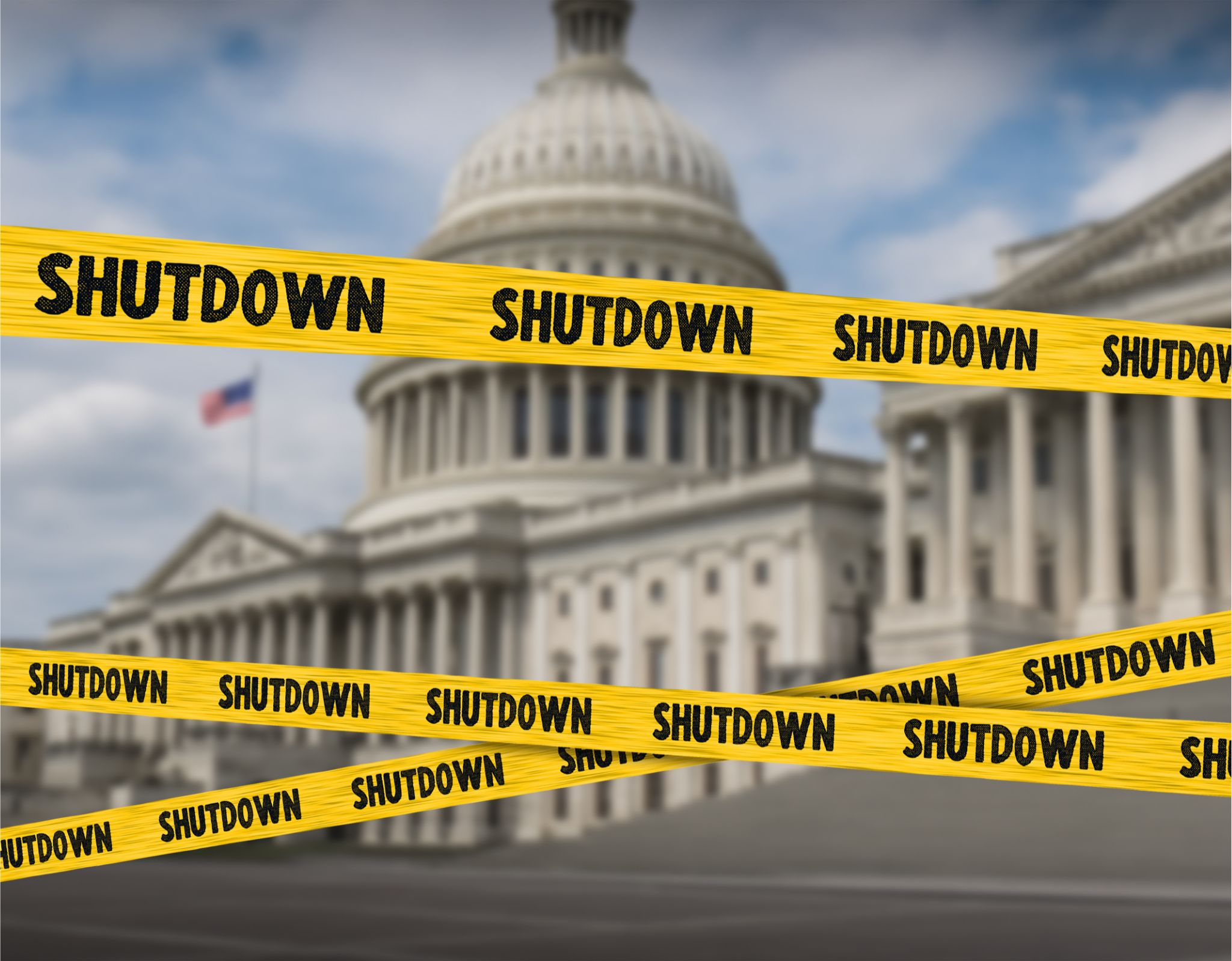
The United States entered a government shutdown on October 1, 2025, after Congress failed to agree on full-year appropriations or a short-term funding bill. Although shutdowns have occurred before, the timing, speed, scale, and motives behind this one make it unique. This is the first shutdown since the last Trump term in 2018–19, which lasted 35 days, the longest in history.For traders, understanding both the mechanics and the ripple effects is essential to anticipating how markets may respond, particularly if the shutdown draws out to multiple weeks as currently anticipated.
What Is a Government Shutdown?
A government shutdown occurs when Congress fails to pass appropriation bills or a temporary extension to fund government operations for the new fiscal year beginning October 1.Without the legal authority to spend, federal agencies must suspend “non-essential” operations, while “essential” services such as national security, air traffic control, and public safety continue, often with employees working unpaid until funding is restored.Since the Government Employee Fair Treatment Act of 2019, federal employees are guaranteed back pay to cover lost wages once the shutdown ends, although there has been some narrative from the current administration that some may not be returning to work at all.
Why Did the Government Shutdown Happen?
The 2025 impasse stems from partisan disputes over spending levels, health-insurance subsidies, and proposed rescissions of foreign aid and other programs. The reported result is that around 900,000 federal workers are furloughed, and another 700,000 are currently working without pay.Unlike many past standoffs, there was no stopgap agreement to keep the government open while negotiations continued, making this shutdown more disruptive and unusually early.
Why an Early Shutdown?
Historically, most shutdowns don’t occur immediately on October 1. Lawmakers typically kick the can down the road with a “Continuing Resolution (CR)”. This is a stopgap measure that can extend existing funding for weeks or months to allow time for an agreement later in the quarter.The speed of the breakdown in 2025, with no CR in place, is unusual compared to past shutdowns. It suggests it was not simply budgetary drift, but a potentially deliberate refusal to extend funding.
Alternative Theories Behind the Early Shutdown
While the main narrative coming from the U.S. administrators points to budget deadlock, several other theories are being discussed across the media:
- Executive Leverage – The White House may be using the shutdown as a tool to increase bargaining power and force structural policy changes. Health care is central to the debate, funding for which was impacted significantly by the “one big, beautiful bill” recently passed through Congress.
- Hardline Congressional Factions – Small but influential groups within Congress, particularly on the right, may be driving the shutdown to demand deeper cuts.
- Political Messaging – The blame game is rife, despite the reality that Republican control of the presidency, House, and Senate, as well as both sides, is indulging in the usual political barbs aimed at the other side. As for the voter impact, Recent polls show that voters are placing more blame on Republicans than Democrats at this point, though significant numbers of Americans suggest both parties are responsible
- Debt Ceiling Positioning – Creating a fiscal crisis early could shape the terms of future negotiations on borrowing limits.
- Electoral Calculus – With midterms ahead, both sides may be positioning to frame the narrative for voters.
- Systemic Dysfunction – A structural view is that shutdowns have become a recurring feature of hyper-partisan U.S. politics, rather than exceptions.
Short-Term Impact of Government Shutdown
AreaImpactFederal workforceHundreds of thousands have been furloughed with reduced services across various agencies.Travel & aviationFAA expects to furlough 11,000 staff. Inspections and certifications may stall. Safety concerns may become more acute if prolonged shutdown.Economic outputThe White House estimates a $15 billion GDP loss per week of shutdown (source: internal document obtained by “Politico”.Consumer spendingFederal workers and contractors face delayed income, pressuring local economies. Economic data releaseKey data releases may be delayed, impacting the decision process at the Fed meeting later this month.Credit outlookScope Ratings and others warn that the shutdown is “negative for credit” and could weigh on U.S. borrowing costs.Projects & researchInfrastructure, grants, and scientific initiatives are delayed or paused.
Medium- to Long-Term Impact of Government Shutdown
1. Market Sentiment
Shutdowns show some degree of U.S. political dysfunction. They can weigh on confidence and subsequently equity market and risk asset sentiment. To date, markets are shrugging off a prolonged impact, but a continued shutdown into later next week could start to impact.Equity markets have remained strong, and there has been no evidence of the frequent seasonal pullback we often see around this time of year.Markets have proved resilient to date, but one wonders whether this could be a catalyst for some significant selling to come.
2. Borrowing Costs
Ratings downgrades could lift Treasury yields and increase debt-servicing costs. The Federal Reserve is already balancing sticky inflation and potential downward pressure on growth. This could make rate decisions more difficult.
3. The Impact on the USD
Rises in treasury yields would generally support the USD. However, rising concerns about fiscal stability created by a prolonged shutdown may put further downward pressure on the USD. Consequently, it is likely to result in buying into gold as a safe haven. With gold already testing record highs repeatedly over the last weeks, this could support further moves to the upside.
4. Credibility Erosion
Repeated shutdowns weaken the U.S.’s reputation as the world’s most reliable borrower. With some evidence that tariffs are already impacting trade and investment into the US, a prolonged shutdown could exacerbate this further.
What Traders Should Watch
For those who trade financial markets, shutdowns matter more for what they could signal both in the short and medium term. Here are some of the key asset classes to watch:
- Equities: Likely to see volatility as political risk rises, and the potential for “money off the table” after significant gains year-to-date for equities.
- U.S. Dollar: With the US dollar already relatively weak, further vulnerability if a shutdown feeds global doubts about U.S. fiscal stability.
- Gold and other commodities: May continue to gain as hedges against political and credit risk. Oil is already threatening support levels; any prolonged shutdown may add to the bearish narrative, along with other economic slowdown concerns
- Outside the US: With the US such a big player in global GDP, we may see revisions in forward-looking estimates, slingshot impacts on other global markets and even supply chain disruptions with impact on customs services (potentially inflationary).
Final Word
The 2025 shutdown is unusual because of its scale and because it started on Day 1 of the fiscal year, without even a temporary extension. That speed points to a deeper strategic and political contribution beyond the usual budget wrangling that we see periodically.For traders, the lesson is clear: shutdowns are not just what happens in Washington, but may impact confidence, borrowing costs, and market sentiment across a range of asset classes. In today’s world, where political credibility is a form of capital, shutdowns have the potential to erode the very foundation of the U.S.’s role in global finance and trade relationships.

